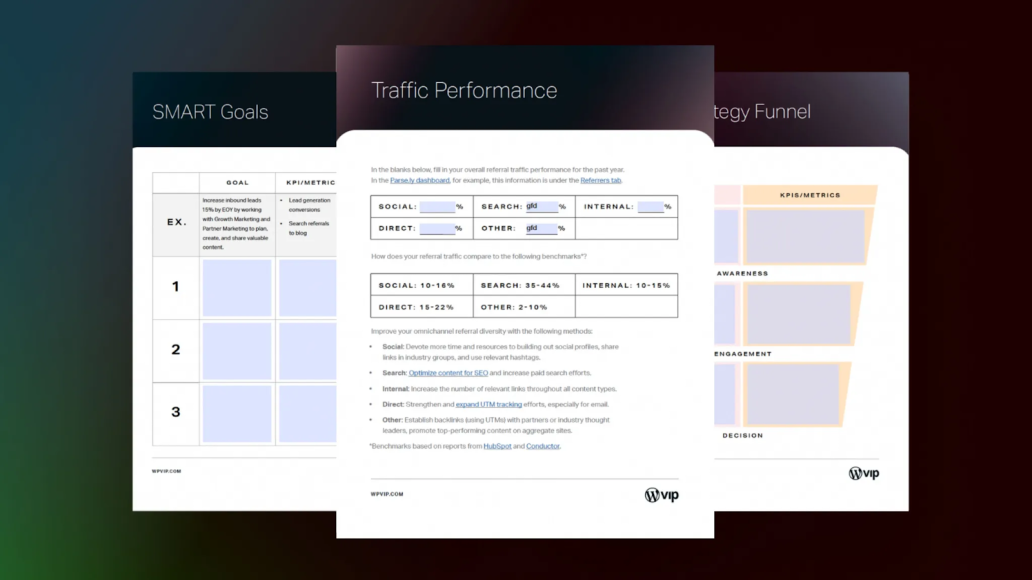How to Reset Your Content Analytics Strategy
This New Year, your resolution should be to use data more efficiently.

As a content marketer, you know it’s a scramble to keep up with the latest trends and strategies to increase website traffic and engagement, especially tying content to ROI.
To stay competitive in today’s crowded digital landscape, and prove the value of your content to leadership, align your content analytics strategy with the goals and metrics that drive your organization.
And what better time to optimize or reset your content strategy than the start of a new year? Here’s how to do that.
- Perform a content strategy health check
- Set SMART content strategy goals
- Diversify your lead-generation channels
- Optimize your conversion strategy
- Set internal benchmarks for success
- Follow a healthy data habits checklist

1. Perform a content strategy health check
Take stock of your content marketing efforts by identifying areas that need improvement or a pivot. The goal here is to understand which metrics (and content) map to different stages of your content strategy funnel.
Look at content themes, formats, and campaigns at each stage of the buyer’s journey. Which KPIs and associated metrics align with each stage? Are those metrics still a strong, relevant indicator of content success?
2. Set SMART content strategy goals
Stay on track with your content marketing efforts by using the SMART model to set goals. Each should be specific, measurable, achievable, relevant, and time-bound. These goals might include increasing website traffic, boosting engagement on social media platforms, or improving your conversion rate (with specific metrics, of course).
You’ll set more realistic content performance goals and highlight any engagement gaps.
Note: If you struggle to pair your goals with your content and metrics, there’s a disconnect in your strategy. Pinpoint where the misalignment occurs and update your content strategy funnel accordingly.
3. Diversify your lead-generation channels
Maximize the effectiveness of your content marketing strategy by publishing and distributing content on a variety of lead-generation channels. If all your traffic comes from one or two channels, you risk losing that traffic should something go south. We know referral traffic isn’t the only indicator of success, but diverse omnichannel referral metrics are strong indicators of a healthy content strategy.
Identify and rank your referral sources and compare them to the benchmarks in our worksheet. If you’re not aligned with those benchmarks, it’s time to enhance your distribution strategy.
You’ll reach more potential customers and drive more conversions by becoming less channel-dependent when driving top-of-funnel (TOFU) traffic and brand awareness.
4. Optimize your conversion strategy
Is your traffic high but conversions low? First, be specific about what conversion means for your team. Attribution models in content analytics tools can help you attribute your content to those valuable visitor actions. But don’t lean on one attribution model alone. Reference data from various models to get the complete picture of your bottom-of-funnel (BOFU) content strategy health.
Here are the four attribution models Parse.ly surfaces in our dashboard:
- First touch: credits the page seen first in the 30 days before conversion
- Linear: shares credit across every page that was seen before conversion
- Last touch: credits the last page (landing page, homepage, product page) where conversion occurred
- Last post touched: credits the last post (blog article, video, ebook) seen before conversion occurred
The more you understand about what attribution and conversion types work best for your goals, the better you optimize your content to push your audience through the funnel.
5. Set internal benchmarks for success
Regularly assess the performance of your content marketing strategy by setting internal benchmarks and tracking key metrics over time. This can help you identify areas for improvement and make adjustments as needed to keep your content strategy on track.
Have you done a content audit or ROT analysis recently? This will help you find an optimal conversion level based on middle-of-funnel (MOFU) marketing efforts by evaluating key metrics like conversions, engaged time, recirculation rate, and more.
6. Follow a healthy data habits checklist
Making a New Year’s resolution, whether it’s getting healthy or becoming data-driven, is a lot easier than sticking to it. But, if you break it down into small manageable tasks—like a checklist—it’s not as daunting.
Set up cadences for data reporting and discussion, reminding your team to regularly check in on content metrics. Set up automatic reports based on your KPIs/metrics for the entire team.
Suggested Parse.ly reports include: Bottom Listings, Top Listings, Stats Over Time.
Keeping data fresh and relevant holds your team accountable for tracking progress against your goals. You’ll prove the value of your content to leadership and make the case for additional resources for your efforts.